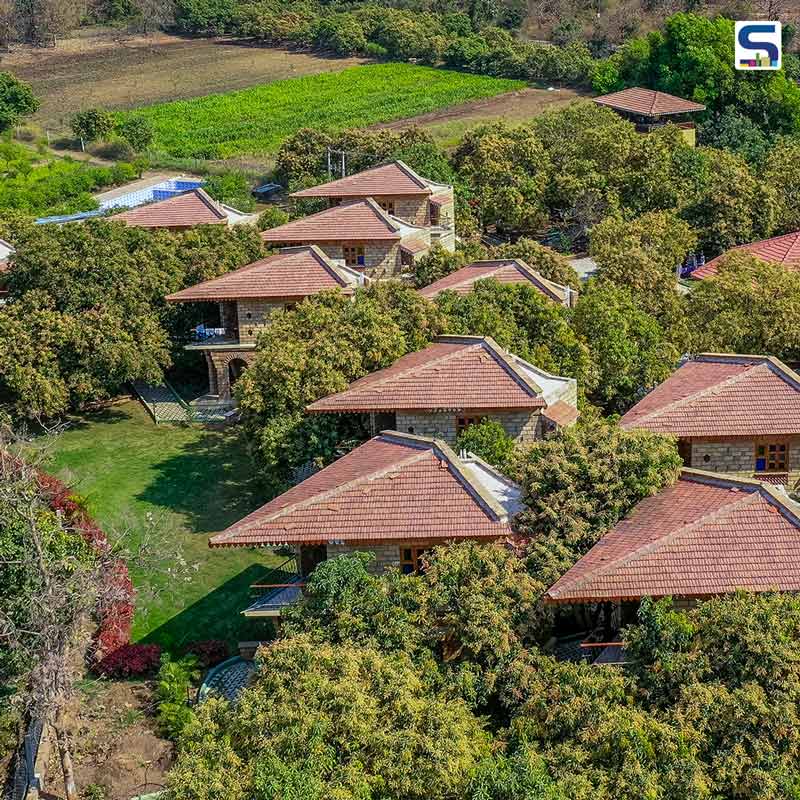
Himanshu Patel from d6thD design studio has designed these striking triangular cottages amidst the foliage of mango trees, on the edge of Gir lion sanctuary in Gir Vihar, Gujarat. Boasting locally available materials like sandstone, bricks, and terracotta tiles, the project not only serves to be economical but also attempts to instill a feeling of pride and belongingness among the visitors. The architect has incorporated vernacular building techniques like rubble stone-packed foundation, load-bearing walls, arches, dome and pitched roofs to create these impressive, sustainable, and welcoming cottages. Keen attention has been paid to creating cottages without disturbing the existing trees. Patel shared his design philosophy and more information about this outstanding project with SURFACES REPORTER (SR). Scroll down to read.
Also Read: This Eco-Resort in Bali Features The Use of Bamboo and Rammed Earth To Minimize The Carbon Footprint | Inspiral Architects
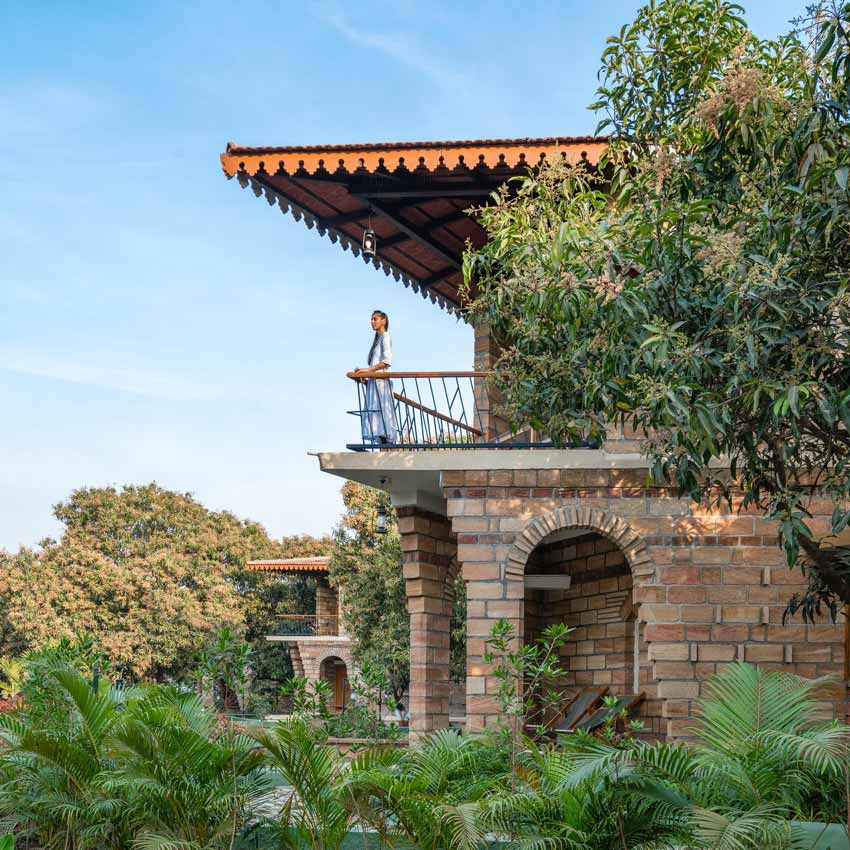
Talking about his design philosophy, the architect says, “The concern for climate as well as economic and cultural sustainability has been looked to incorporate into the design without which sustainability may not work in the Indian context.
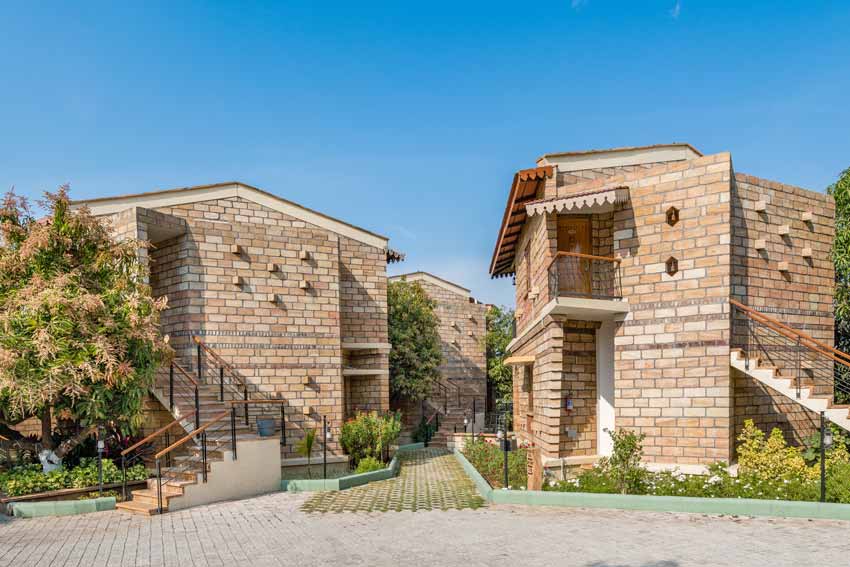
Rather than spending millions on the best technology to create the greenest of green buildings when very few Indians can associate with them and even fewer can afford, architects have come up with simple, established, and honest practice offered by vernacular architecture”
Why Triangular-Shaped Cottages?
"The site was a mango farm having trees at a 30 feet interval in the grid. Considering the huge foliage of mango trees, it was very challenging to build cottages without chopping out the trees and this constraint of the site became the source of creativity and ingenuity," said Himanshu.
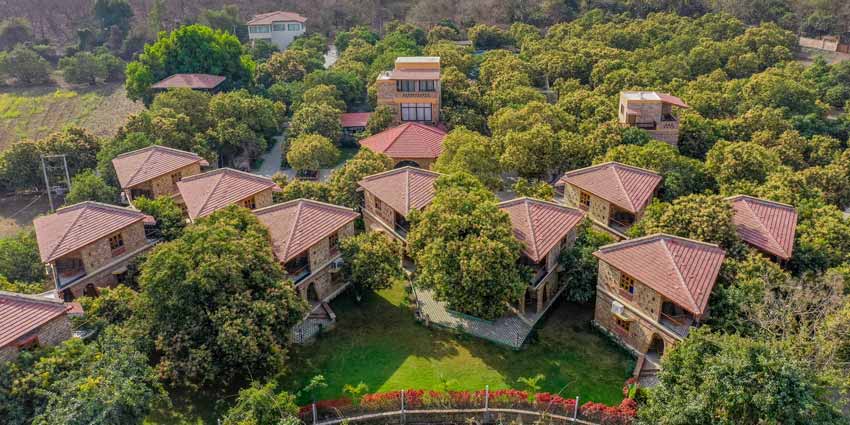 He came up with the triangular-shaped cottages which took the place around mango trees effortlessly and beautified the scheme. Also looking at an earthquake-prone zone of the site location, using the stable triangular form is a wiser choice especially when the entire structure is built with load-bearing walls out of locally found sandstone in order to minimize the use of cement concrete.
He came up with the triangular-shaped cottages which took the place around mango trees effortlessly and beautified the scheme. Also looking at an earthquake-prone zone of the site location, using the stable triangular form is a wiser choice especially when the entire structure is built with load-bearing walls out of locally found sandstone in order to minimize the use of cement concrete.
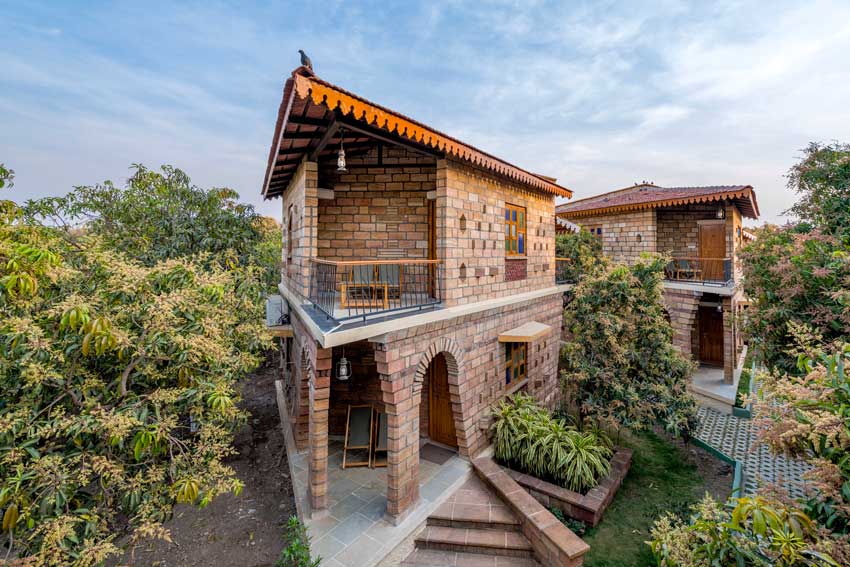
Distinctive Plays of Geometries and Volumes in The Entrance
As one enters the site, one is welcomed with a distant eye-pleasing view of various plays of geometries and volumes but ambiguity and uncertainty hold one’s hand until one walks to a more distinguished reception area which is covered with a dome and vibrantly glows with the rays of light from the skylight above.
Cottages’ Orientation Allows Diffused North Sunlight In Triangular Balconies
All cottages are north-south oriented to take in the diffused north light in balconies from where the couple spends most of their time enjoying the panoramic view of the adjoined forest.
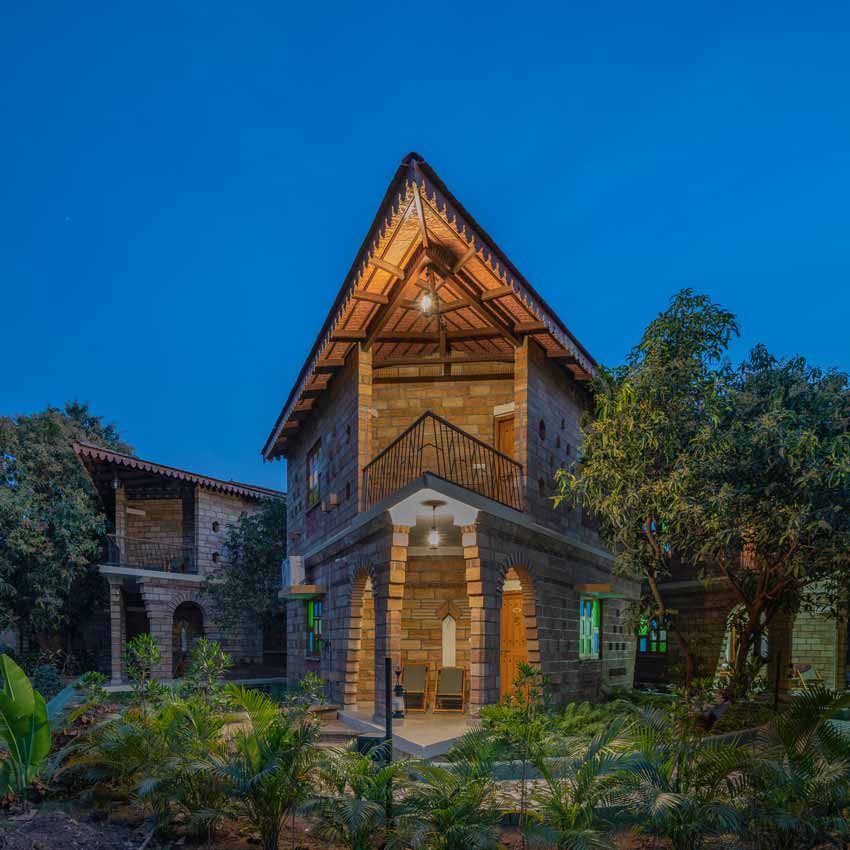
What acts as a foyer space for the ground floor turns to be the balcony for the upper floor when the triangles are stacked systematically. A certain flavor of awe and possibility takes birth when one views the vastness of life from the converging triangular balconies.
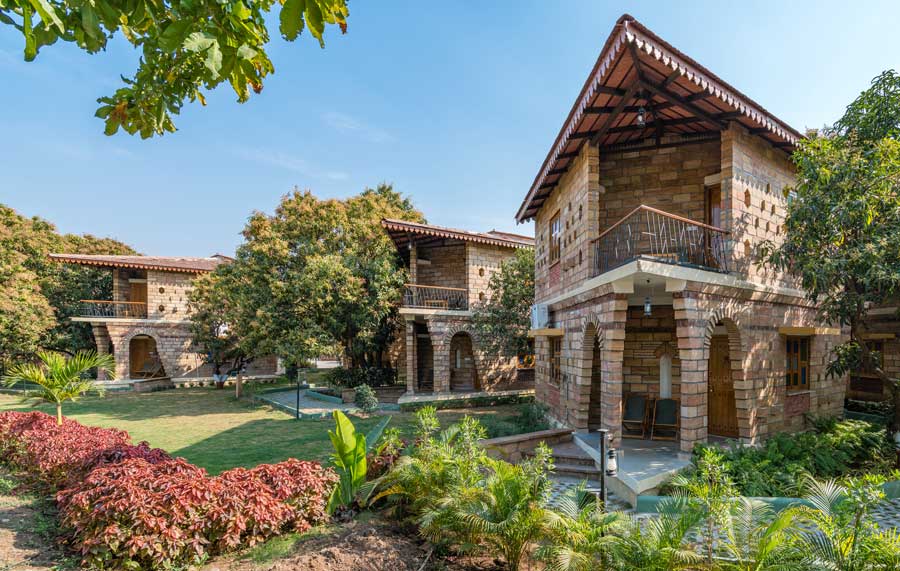 Moreover, L-shaped staircases leading to the upper floors add play and offer various perspectives to enjoy the beauty of solid stone mass-created due to bathroom walls in the south.
Moreover, L-shaped staircases leading to the upper floors add play and offer various perspectives to enjoy the beauty of solid stone mass-created due to bathroom walls in the south.
Also Read: A Wavy Façade using Clay Roof Tiles by Ar Manoj Patel, Manoj Patel Design Studio, Gujarat
Adaptable and Comfortable Restaurant Block
Centrally placed restaurant block on the site is designed to be the most flexible and comfortable to all.
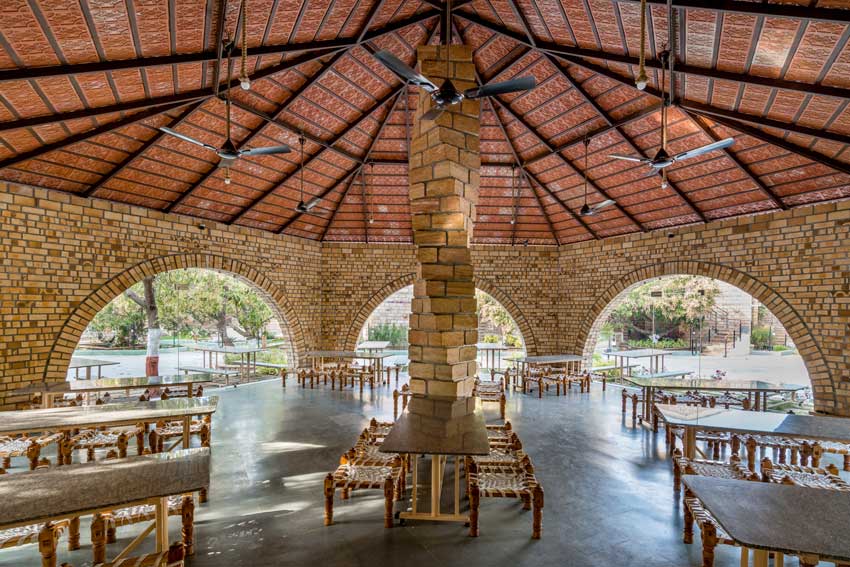 The central spiral stone pillar supporting the hexagonal roof acts as a pivot for the entire site wherein all activities smoothly flow around the block. The large brick arches of the dining hall interestingly frame the scenes of the exteriors and the extended outdoor seating sensitively blurs the boundaries of open and built.
The central spiral stone pillar supporting the hexagonal roof acts as a pivot for the entire site wherein all activities smoothly flow around the block. The large brick arches of the dining hall interestingly frame the scenes of the exteriors and the extended outdoor seating sensitively blurs the boundaries of open and built.
Fortified Connection With Nature
The free-flowing spaces and the uninterrupted movements all minutely add up to create a drama wherein visitors’ inquisitiveness urges them to experience something unique and unexplored step by step.
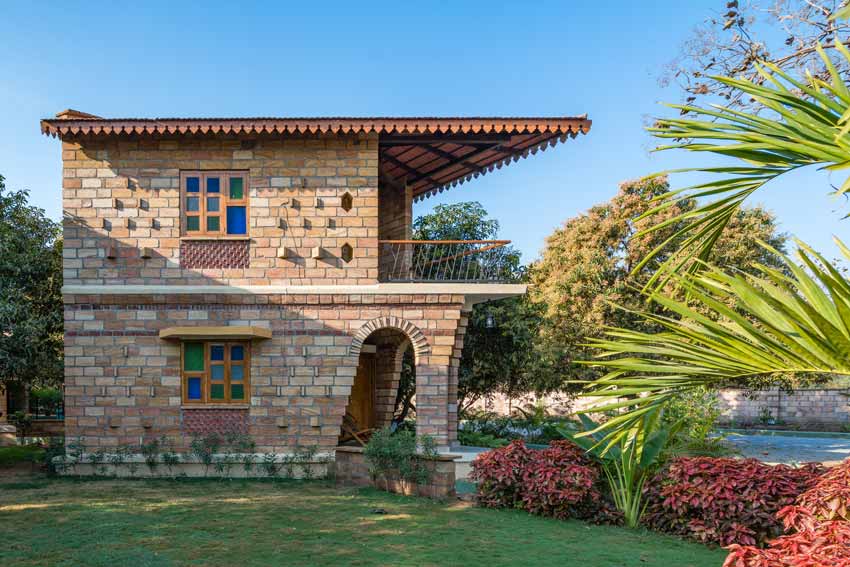
The undisturbed, uncut mango trees proudly stand between the buildings which become an inseparable and important part of the architectural vocabulary. Inbuilt sit-outs from sandstone below mango tree allow for an intimate interface with the outdoors where you actually wouldn’t need a book.
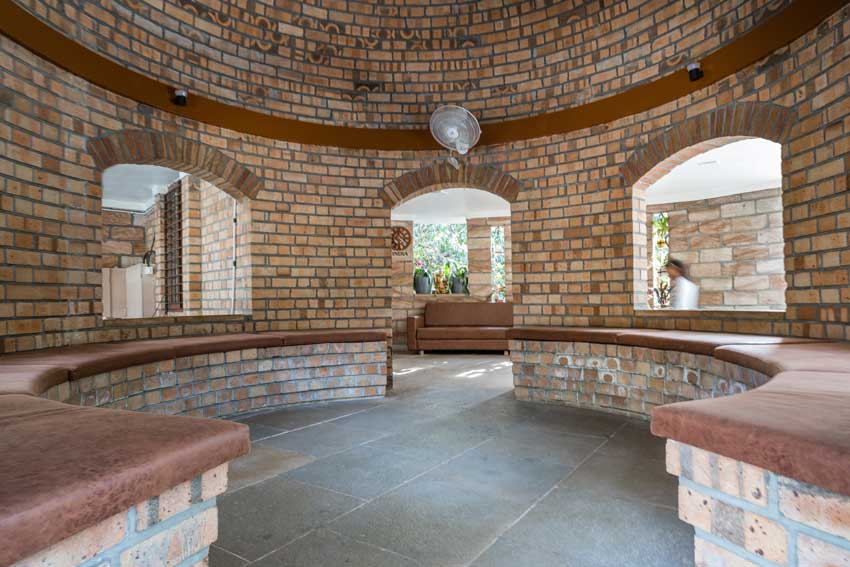
Stone walls use locally available sandstone in their naked form, giving the entire resort a very natural feel. Clay roofing tile and exposed stone surfaces will gradually get covered with radiant moss; nature will fight its way back. Living in a forest is all about witnessing this war.
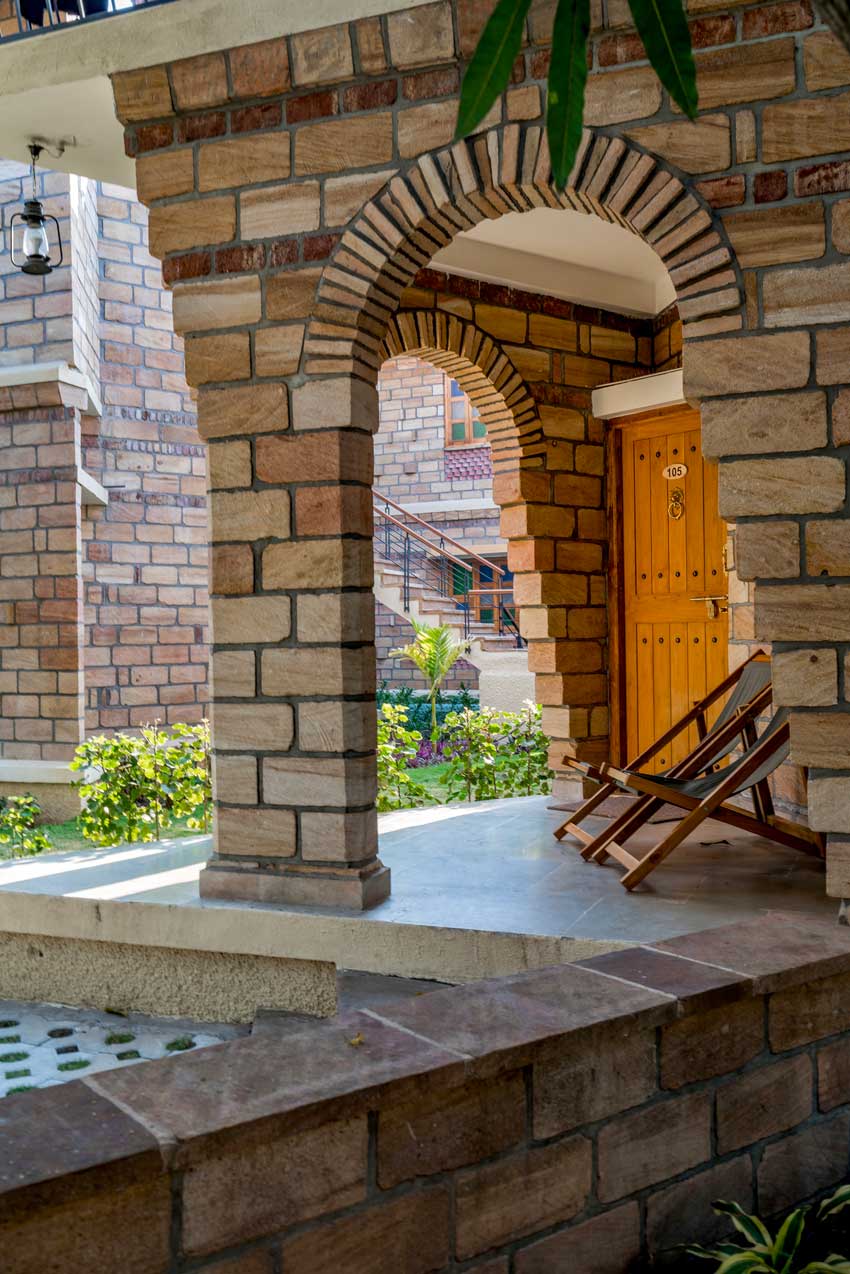
When such simplicity and human craftsmanship are given the highest value, it is then that the architect’s idea of design comes to life and a resort-like GirVihar starts to blossom to its ultimate potential.
Project Details
Project Name: Gir Vihar Eco Resort
Design Firm: d6thD design studio
Principal Architect: Himanshu Patel
Photography: Inclined studio
Text: Shubhangi Singla
Location: Bhojde village, Gir lion sanctuary, Gujarat, India
Built-up area: 1600 sq. mt
Site area: 2.5 acres
No. of cottages: 20
Cost: 2 Cr INR
Completion: 2020
Client: Mr.Vijay Talaviya
Drawings: Dashmeet, Nitin, Yohan
Construction Team: Jagdish, Manu, Jitu
About Firm
d6thD means The 6th dimension to “feel good”. The 6th dimension is not restricted to measure the physical world but to explore the Feel Good Spaces. Any object or space can be measured in 3 Dimensions but to feel good about it is the 6th dimension. d6t promotes the use of locally available materials, traditional building techniques, culturally and climatically relevant building design. They are passionate about design, but driven by ideas rather than personalities. They are interested in exploring the ways in which spaces can create experiential happiness. d6t visualizes the practice as a sheltered and collaborative place for reflection, where a community (including clients and other collaborators) can reflect on how to make life happy and feel good through architecture.
About Architect
Himanshu Patel is an ardent architect (2006) from M.S. University, Baroda. After graduation, he has worked in one of the foremost international architectural firms (arif & bintoak) in Emirates. His research work as a cm fellow (2009) on high-profile Gujarat tourism projects has been well recognized on social development under the Chief Minister’s Fellowship Program. His practice in vernacular architecture is inextricably bound with his entire childhood spent in a village. Since last seven years, his village based d6thD design studio promotes the use of locally available materials, traditional building techniques, culturally and climatically relevant building design.

Himanshu Patel, Principal Architect, d6thD design studio
Keep reading SURFACES REPORTER for more such articles and stories.
Join us in SOCIAL MEDIA to stay updated
SR FACEBOOK | SR LINKEDIN | SR INSTAGRAM | SR YOUTUBE
Further, Subscribe to our magazine | Sign Up for the FREE Surfaces Reporter Magazine Newsletter
Also, check out Surfaces Reporter’s encouraging, exciting and educational WEBINARS here.
You may also like to read about:
Sanjay Puri Architects Designs This Sustainable Resort Using Natural Clay Rocks | La Serenita
Get Immersed In The Scenic Beauty of this Agriculture Farmstay in Gujarat Featuring Terracotta Tiled Roof | d6thD
And more…